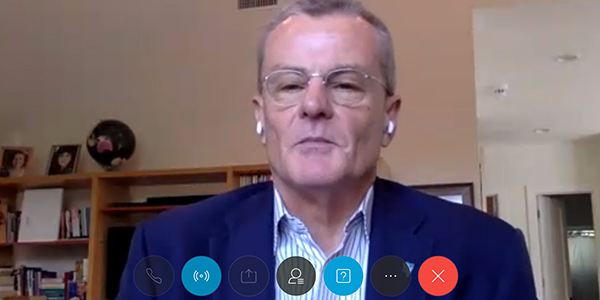The world changed for American Electric Power’s Scott Smith in early March when the coronavirus pandemic forced Ohio Gov. Mike DeWine to partially shut down Columbus’ annual professional bodybuilding event.
“The Arnold,” as it’s called locally, is no ordinary strongman competition. Named after Arnold Schwarzenegger, the Arnold Sports Festival annually attracts more than 20,000 competitors from more than 80 countries to Ohio’s capital.
“It was a watershed moment for us,” Smith, AEP’s senior vice president of transmission field service, said last week during an online Gulf Coast Power Association panel discussion.
“It’s the largest convention in Ohio, other than [Ohio State University football],” he added.
AEP leadership quickly dusted off a plan it had developed after the H1N1 pandemic in 2009 and by mid-March had sent much of its corporate staff home. Now, AEP’s executives are wondering whether they’ll even have some staff return to the office.
“We originally thought we would come back to work the same as before, but it’s not business as usual,” Smith said during the discussion Thursday. “There’s going to be the new normal. We’re in the beginning stages of figuring out that and the protocols around it.”
Smith was joined on GCPA’s panel, “The Future of Work in the Age of Pandemics,” by ERCOT CEO Bill Magness, who said he has the same thoughts. The Texas grid operator also sent its corporate staff home in mid-March. Their stay-at-home orders have since been extended through September.
“We ended up with about 95% of our people working off-site, and there they remain,” Magness said.
ERCOT and AEP have since been using federal guidelines and social-distancing and hygiene practices to determine how best to safely bring back employees. Today’s open-office concepts mean companies will have to rely on shields for workspaces and faces if staff are going to return to their workspaces.
“We’re not going to be able to keep 6-foot distancing for everyone in their cube,” Smith said, noting he sits in an office that is 80% open space.
“We’re thinking hard about this,” Magness said. “Is it better to maintain the performance of the people on your team by keeping them where they are in a remote environment, or bring them back to the way we used to be? From a business perspective, what’s going to help the business the most? What helps the most is productive employees.
“If we only have a somewhat limited number of people in the footprint, we may not be able to bring people back to sit where they use to sit. We may have A Team/B Team arrangements. We’re learning a lot about what the future is going to look like. It’s been fascinating.”
A recent Upwork survey of hiring managers revealed that more than half the nation’s workforce is working remotely. Managers are planning for almost 22% of their workforces to be entirely remote in five years and for the expected growth rate of full-time remote work during that time to more than double, from 30% to 65%.
It may seem counterintuitive, but the survey also found 32% of managers say remote work has increased productivity. That’s because of a lack of commute, less nonessential meetings and fewer distractions than in the office, according to the survey.
“We’ve learned that we have a lot of employees who can get their work done remotely. We’ve traditionally never thought that way,” Smith said. “We’ve found the production of a lot of folks is up because they can get things done at home. Their days may extend to 6:30, 7:30 at night because of all the phone calls and time differentials. It’s actually very interesting. There are going to be a few persons who have to be at work, but we’re questioning who does really need to come back in the office.”
“Part of what’s challenging is people want to get back to work,” Magness said. “We’ve never stopped working, but people want to get back to their environments. Those environments are not what [they were].”
Staying the Path
In contrast, protecting employees in the field or control rooms is much easier. Smith said AEP’s work crews complete health self-assessments each day on an app. If an employee answers positively to one of the questions, their supervisor gets an email that indicates the employee needs to stay home.
“That’s our first line of defense: the employee staying home,” he said. “We’re asking employees, as best they can, to separate themselves with their vehicles. If there are three or four of them working on an issue, we may have three or four trucks at the jobsite, just to maintain social distancing.”
Austin-based ERCOT has isolated controllers in its two operations centers in nearby Taylor and Bastrop. When a 12-hour shift ends in Taylor, the next shift begins in Bastrop while the Taylor ops center is sanitized.
Smith said the remote work environment has revealed a need for different ways of communicating. Zoom and Microsoft Teams can only go so far in bringing together staff from disparate locations and instilling a sense of camaraderie.
“It’s very hard to replicate face-to-face time with electronic tools,” he said. “One of the things we find, like staff meetings on the web, is someone makes a joke, but no one hears anyone laugh. Everyone’s on mute. That kills camaraderie right there.”
“That’s right! That’s a terrible thing,” Magness responded.
Turning serious, Magness said the current environment has left him pleased with staff’s ability to get their work done in a difficult setting.
“From ERCOT’s perspective, we’re really gratified with the way people have stepped up,” he said. “We have to remember this is unusual. This is odd. People will have different reactions to this. We need to constantly think about who we were when we started this, who do we want to be, and how do we stay on that path until this is over.”





